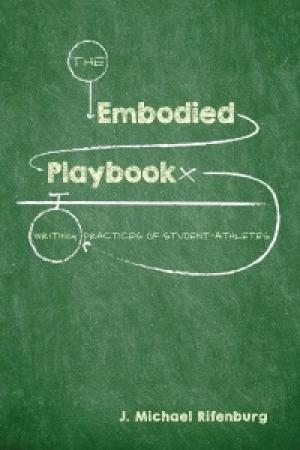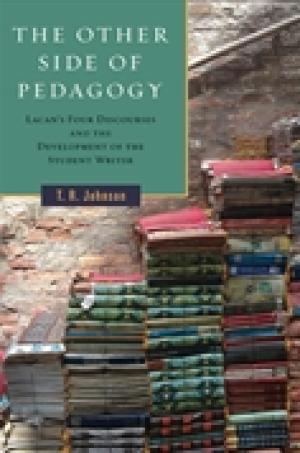Resources by Crystal Benedicks

Michael Rifenburg begins and ends his book with the melancholy story of a student who didn’t make it. A freshman at Auburn University, “Trey” was a star on the football field, but a dud in his classes. Rifenburg – then a master’s student working as a tutor for athletes – tries to help him, but it doesn’t work. When the Auburn football team wins a national championship a few years later, Trey has already dropped out and disappeared. Rifenburg’s book helps us understand what went wrong with Trey’s education. His ultimate argument – that writing teachers can better support student-athletes by understanding the embodied knowledge they bring from the playing field to the writing classroom – asks teachers to see the hidden talents in even those students labeled remedial. Rifenburg pushes past both the “dumb jock” stereotype and the tension that exists between academics and athletics in many colleges. He breaks down these misconceptions and boundaries to explain student-athletes as possessors of “a prior knowledge honed through bodily engagement with text and through writing practices that privilege the body as a central mode of meaning making” – a knowledge that has long gone unrecognized and untapped in the writing classroom, where the abstract practice of writing can seem disconnected from physical experience (5). As a graduate of Division I sports powerhouses like Auburn and the University of Oklahoma – where he worked in a writing center dedicated to serving student-athletes – Rifenburg is well-poised to make this argument. He was embedded for a season with the University of North Georgia’s men’s basketball team, where he attended practices and interviewed players and coaches about how they make meaning on the field. He performs detailed readings of baffling football plays from Auburn’s thick playbooks. His conclusion is that student-athletes learn complex theoretical plays through physical engagement, with the implication that this kind of learning is multi-modal, exacting, and collaborative – and potentially transferable to the traditional writing classroom. He concludes that student-athletes learn their sport through three “cognitive processes”: spatial orientation (or understanding their bodies in relationship to other bodies on the field), haptic communication (or physical touch, as when a coach re-positions a player’s hips), and scaffolded situations (or the step-by-step process through which players build up to learning a complex play). For Rifenburg, these skills are not that different from what writers do: position their ideas in relationship to other peoples’ (or spatial orientation), understand writing as a communal activity that takes place within and between groups of people (or haptic communication), and build upon many early drafts to create longer, complex texts (or scaffolded situations). He ends by prompting the reader to ask how these cross-currents between writing and playing can be leveraged to support student-athlete writers in the classroom. In the end, Rifenburg raises more questions than he answers. His description of the analogy between writing and playing sports is original and clear-sighted, but it remains only an analogy, as he stops short of offering strategies for putting this insight into action – an odd lacuna for a book that places so much emphasis on concrete, embodied experience. Indeed, I often found myself mindful of what is left out of Rifenburg’s book. While he displays deep familiarity with the field of writing studies, he does not acknowledge gender studies or disability studies, fields that are historically groundbreaking in exploring embodied meaning. Similarly, Rifenburg’s focus is exclusively on men playing high-profile, competitive, aggressive sports; do other types of athletes experience bodily knowledge differently? What of swimmers, runners, or dancers? Women athletes? Do student-athletes at small liberal arts colleges or community colleges – where athletics are not as prominent – experience a different kind of relationship between sports and academics? Rifenburg’s study opens the door for many important inquiries to follow. Ultimately, he provides a model for thinking about matter, mind, and underexplored student expertise.

Readers of T.R. Johnson’s ambitious The Other Side of Pedagogy: Lacan’s Four Discourses and the Development of the Student Writer will find some unexpected juxtapositions: Ouija boards and zombies side by side with Hannah Arendt and Keith Richards, student writers jostling with hysterics and narcissists. From this amalgam of unlikely characters, Johnson’s more conventional thesis emerges: contemporary education lacks a sense of its goals, other than a vague notion that student development means initiating students into a loosely-defined ideal of the academy. Johnson suggests that we can rescue ourselves and our students from this stagnation by recognizing what has been there all along: the pulsing unconscious, the unbidden and ultimately irrepressible system of desire that we all carry around with us but like to pretend we do not. This evocation of the unknowable and uncanny is what mobilizes Johnson’s playful evocation of high and low culture. Johnson posits a model of student development based on Lacan’s famous lecture series of the late 1960s. Student writers, Johnson argues, move through four stages, as articulated by Lacan in his theory of the four main types of discourse. In the first two stages, the discourses of mastery and of the University, students are passive receptacles of teacherly authority, their unconscious ideally repressed and their prose, when they can write at all, “empty mimicry” (133). The last two discourses are where things get really interesting. The third discourse is that of the hysteric, whose appearance is “a singularly disruptive performance . . . wreaking havoc with the conventional, lockstep procedure of the bureaucracy, as when Marlon Brando’s character in The Wild One, when asked what he is rebelling against, responds ‘Whaddya got?’” (195). Here, Johnson offers a useful reframing of the problem student, the eye-roller, the note-passer, the interrupter. Instead of understanding these students as impediments to classroom coherence, Johnson casts them as paradoxically more advanced than the good student who always has the right answer. These disruptive students are engaging the unconscious when they exceed and unsettle the roles prepared for them, the social assumptions about who and what they ought to be. However, like Keith Richards writing “I Can’t Get No Satisfaction” in his sleep, the hysteric cannot control his or her discourse, but rather “stumble[s] in a narcotic dream from one summit to the next” (188). The final discourse is that of the analyst, a discourse marked by humility, openness, and equality. To explain this discourse, Johnson imagines a class in which students and teacher listen carefully to one another and thus arrive at unexpected and unplanned places, a class in which students write papers that put multiple texts in conversation with one another to see what emerges. These students and teachers harness the unconscious to the extent that they are engaged in dialogue with the other. If we seek to sustain these productive engagements, we must realize that “the aim of our courses is ultimately to teach our students to love – specifically, to love working and playing with words and texts and ideas, and, through these, to love each other, the wider world, and the ideal of justice, more and more and more” (207). These are inspiring words, and perhaps the most evocative explanation I’ve ever heard of why pedagogical practices like service learning and community engagement – which court unexpected moments of empathy and, ideally, writing and thinking that resonate beyond the self and the stale loop of teacher-oriented writing – are so critical to breathing life into our institutions. One of Johnson’s most powerful contributions in this book is his insistence on seeing students and teachers as complex, embodied people who bring the fullness of their selves and their unconscious desires with them into the classroom. Throughout, I found myself recognizing myself and my students, and recognizing myself in my students. Johnson’s appeal to our fullest personhood allows him to think of pedagogy as a way of understanding people interacting with people, ideas with ideas, and not as a goal-oriented assessment task. Yet, while Johnson’s unpacking of Lacan’s four discourses is illuminating, the way he frames them as a linear developmental schema – something, he acknowledges, Lacan never intended – is at odds with the more associative, recursive nature of the unconscious itself. That is, for a book that delights in the juxtaposition of high and low culture, its structural principles are over determined, as if Johnson is trying to contain the very unconscious he is unleashing. Finally, Johnson’s book fits squarely into a recent trend in composition studies: the urge to retell the history of the field to highlight a neglected thread that, when exposed, could reinvigorate our teaching. Indeed, Johnson spends the first half of the book detailing an exhaustive history of psychoanalysis’s second-class status in the history of writing pedagogy. Byron Hawk’s A Counter History of Composition (2007) and Donna Strickland’s The Managerial Unconscious in the History of Composition Studies (2011) are two examples of recent books that do something similar, turning to psychoanalytic theories of desire and repression to get at what is unknowable, almost magical, about both the activities of writing and of teaching. Johnson’s text is an imaginative and welcome, if sometimes unwieldy, addition to this new canon of writing pedagogy.